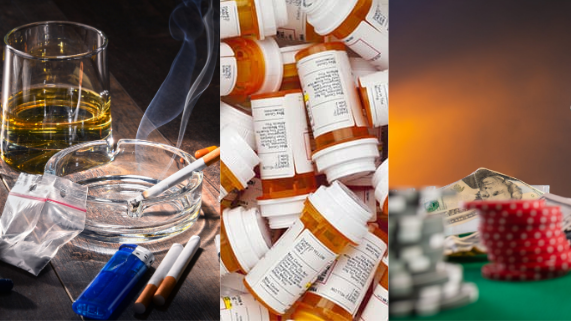
Nicotine dependence (also called tobacco addiction) involves physical and psychological factors that make it difficult to stop using tobacco, even if the person wants to quit. Nicotine releases a chemical called dopamine in the same regions of the brain as other addictive drugs. Since cigarettes are legal and have mild side effects, people often assume that cigarettes are not as harmful as other forms of addiction. The reality is that tobacco causes more deaths than other addictions.
Alcoholism is the inability to control drinking due to both a physical and emotional dependence on alcohol.
Marijuana is a Psychoactive drug that alters perception. Marijuana contains THC: the chemical compound that causes the drugs psychedelic, “high.” THC also determines the potency and strength of the substance. The effects of Marijuana may be different for everyone and depend on how it is consumed; smoking Marijuana produces a faster, shorter-lived high than taking it orally. Wax or shatter affects the user immediately and may last for hours depending on the concentration of THC. Marijuana is a drug acquired from the Cannabis plant. The plant is typically dried out, ground up, and smoked (in paper, like a cigarette, or in a pipe, like tobacco). Marijuana also comes in the form of “edibles.” Edibles are foods, such as baked goods and candies, that contain either one or both of Marijuanas active ingredients: tetrahydrocannabinol (THC) or cannabidiol (CBD). Like smoking, edibles produce the same effects, with a differing amount of time between intake and feeling the effects.
One of the most frequent reasons people go to the doctor is for pain relief. A number of different drugs can ease pain. About 20% of people will get a medication called an opioid. You may also hear your doctor call it an opiate or a narcotic. These pain relievers are historically made from opium, which comes from the poppy plant, although synthetic lab-made opioids also exist. Now called opioid use disorder (OUD), painkiller addiction was a term used for years along with terms like opioid abuse, drug abuse, drug dependence, and drug addiction. 16million people as of 2022 are dependent on opioid use.
It is extracted from the leaves of Erythroxylon coca (E. coca), also known as the coca scrub, a plant that grows in the Andean highlands of South America. It is the most powerful stimulant of natural origin. As a recreational drug, cocaine is known as powder, snow, ski, soft, blow, slopes, coca, marching powder, benzoylmethylecgonine, and nose candy.
Heroin is a drug that comes from a flower, the opium poppy, which usually grows in Mexico, Asia, and South America. Its very addictive. It can look like a white or brown powder, or a sticky black “tar.” Its also called horse, smack, junk, and brown sugar, among other names. Many people smoke or snort heroin. Most users inject it into their veins. Thats the most dangerous way to take it, because its easier to overdose and you can catch a disease from a dirty needle. Many people start using heroin to deal with anxiety, worries, and other stressors. One study found that 75% of users had mental health issues such as depression, ADHD, or bipolar disorder.
A gambling addiction is a progressive addiction that can have many negative psychological, physical, and social repercussions. It is classed as an impulse-control disorder. Problem gambling is harmful to psychological and physical health. People who live with this addiction may experience depression, migraine, distress, intestinal disorders, and other anxiety-related problems. As with other addictions, the consequences of gambling can lead to feelings of despondency and helplessness. In some cases, this can lead to attempts at suicide.
By way of a definition, “sex addiction” is described as a compulsive need to perform sexual acts in order to achieve the kind of “fix” that a person with alcohol use disorder gets from a drink or someone with opiate use disorder gets from using opiates. Its believed that a person with sex addiction will seek out multiple sex partners, though this in itself is not necessarily a sign of a disorder. Some report that it may manifest itself as a compulsive need to masturbate, view pornography, or be in sexually stimulating situations.
Internet Addiction Disorder (IAD) ruins lives by causing neurological complications, psychological disturbances, and social problems. Surveys in the United States and Europe have indicated alarming prevalence rates between 1.5 and 8.2% [1].